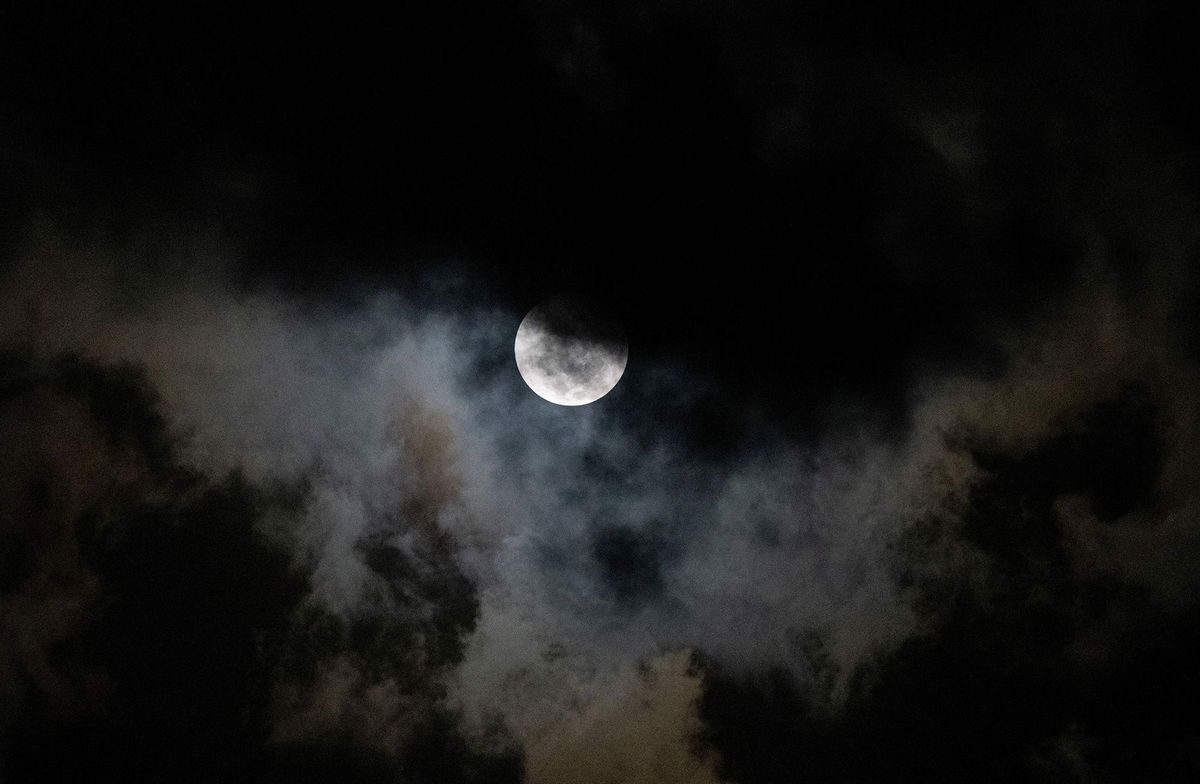A partial eclipse took a ‘bite’ out of the harvest supermoon. See the stunning images

The moon is seen through the clouds during a partial lunar eclipse over Caracas
(CNN) — Sky-gazers around the world were able to glimpse a partial lunar eclipse while September’s full harvest moon shone brightly Tuesday night.
The moon peaked at its fullest at 10:35 p.m. ET Tuesday, but will appear full through Thursday morning, according to NASA.
If you viewed the moon on Tuesday evening, for about an hour it also appeared as if a bite has been taken out of it due to a partial lunar eclipse. A partial lunar eclipse occurs when Earth moves between the sun and the full moon without being perfectly aligned. The celestial event appeared over Europe and much of Asia, Africa, North America and South America.
The moon entered Earth’s full shadow at 10:13 p.m. ET and exited it at 11:16 p.m. ET. The peak of the eclipse was expected to occur at 10:44 p.m. ET, according to NASA.
During a total lunar eclipse, Earth’s shadow can turn the moon’s surface a striking red color, which is known as a blood moon, according to NASA. But that won’t be the case this week, experts say.
“The eclipse (Tuesday) will not be a total lunar eclipse, so the moon won’t appear red, instead a portion of the moon will darken,” said Noah Petro, NASA project scientist for both the Lunar Reconnaissance Orbiter and Artemis III.
“If you didn’t know it were happening or even look at the moon it might not be noticeable. But the keen observer may notice the ‘top right’ corner of the moon darker than the rest of the moon,” he said via email. “This is the part that is completely in(Earth’s) shadow, though not a large portion of the moon will be in darkness. But if its clear out I encourage folks to go out and look, it’s always worthwhile to look at the moon!”
September’s full moon is also considered the second of four consecutive supermoons expected in 2024, according to NASA. Definitions of a supermoon can vary, but the term generally denotes a full moon that is closer to Earth than normal and thus appears larger and brighter in the night sky. Some astronomers say the phenomenon occurs when the moon is within 90% of perigee — its closest approach to Earth in orbit.
While the typical distance between Earth and the moon is an average of 238,900 miles (384,472 kilometers), September’s full moon was expected to be just 222,637 miles (358,300 kilometers) away, according to NASA.
And keep an eye out for Saturn, which will look like a bright dot close to the full moon.
Naming the moon
The name harvest moon is a nod to the season because the event happens close to the beginning of fall, or the autumnal equinox, which occurs on September 22.
Many people associate the harvest moon with being orange in color as it begins to rise, but the same could be said of all full moons. The hue is due to the greater thickness of Earth’s atmosphere near the horizon, according to EarthSky.
Typically, this time of year is when many summer-planted crops peak in the Northern Hemisphere, and the bright moon once helped farmers work into the evening to harvest their bounty ahead of the first frost, according to The Old Farmer’s Almanac.
Other monikers for September’s full moon — as used across various indigenous tribes — include the “moon of full harvest” from the Hopi people, the “corn maker moon” from the Abenaki tribe, the “moon of the brown leaves” from the Lakota people and “autumn moon” from the Passamaquoddy tribe.
European names for the moon also honor the fall harvest, including the “fruit moon,” a nod to the fruits that ripen as summer ends, and the “barley moon” to mark when the crop is collected from the fields, according to NASA.
Other harvest-celebrating traditions around this time include the Korean festival of Chuseok and the Chinese Mooncake Festival, both of which also celebrate family and the remembrance of ancestors.
Upcoming celestial events
The next full moon, the hunter’s moon occurring on October 17, will also be a supermoon and the closest of the year at 222,095 miles (357,428 kilometers) away.
The beaver moon will occur on November 15, and the final full moon of the year will be the cold moon on December 15.
Meanwhile, sky-gazers can anticipate a busy meteor shower season to close out 2024. Here are peak dates for upcoming celestial activity, according to the American Meteor Society:
Draconids: October 7-8
Orionids: October 20-21
Southern Taurids: November 4-5
Northern Taurids: November 11-12
Leonids: November 17-18
Geminids: December 13-14
Ursids: December 21-22
The-CNN-Wire
™ & © 2024 Cable News Network, Inc., a Warner Bros. Discovery Company. All rights reserved.